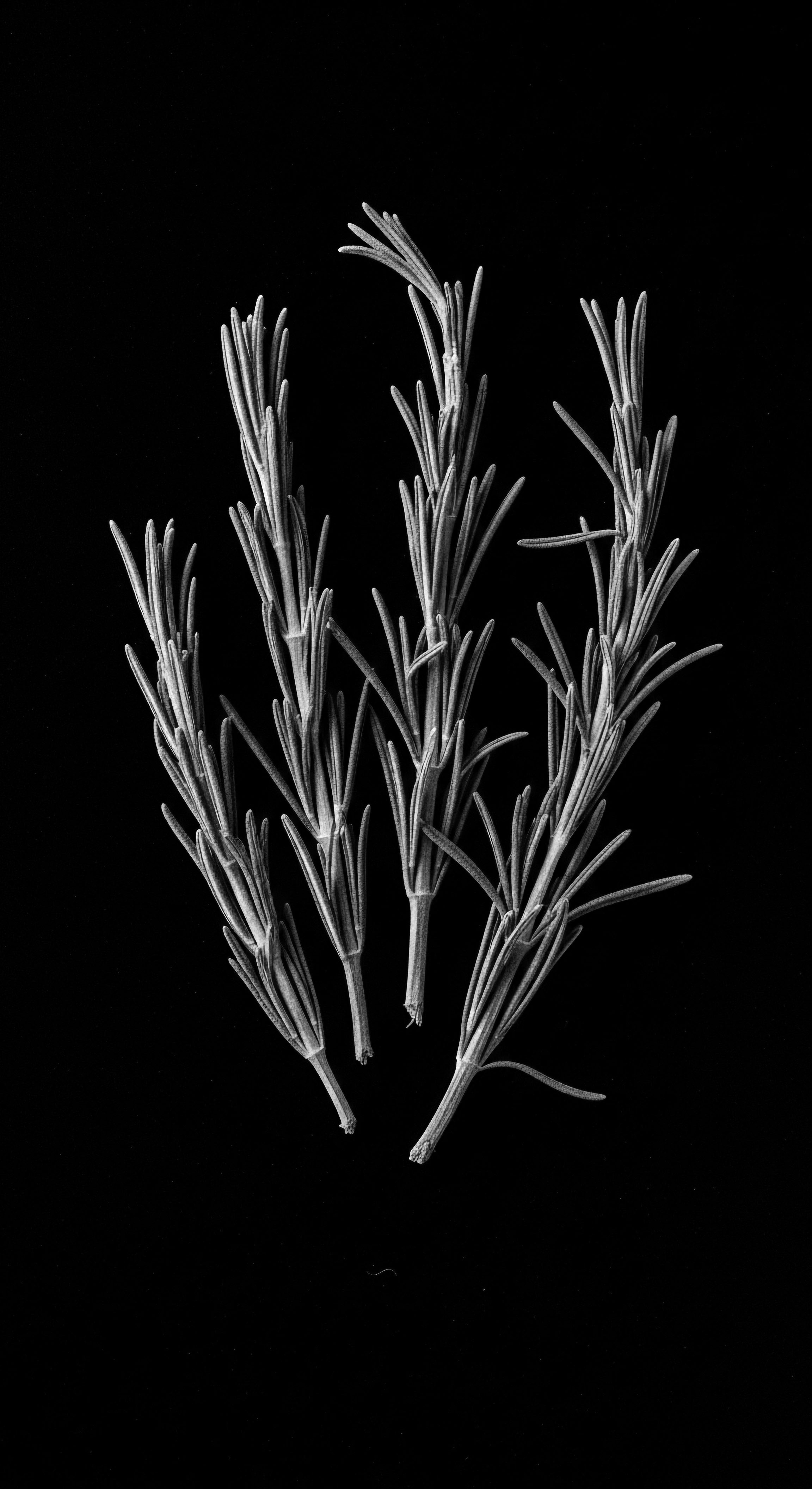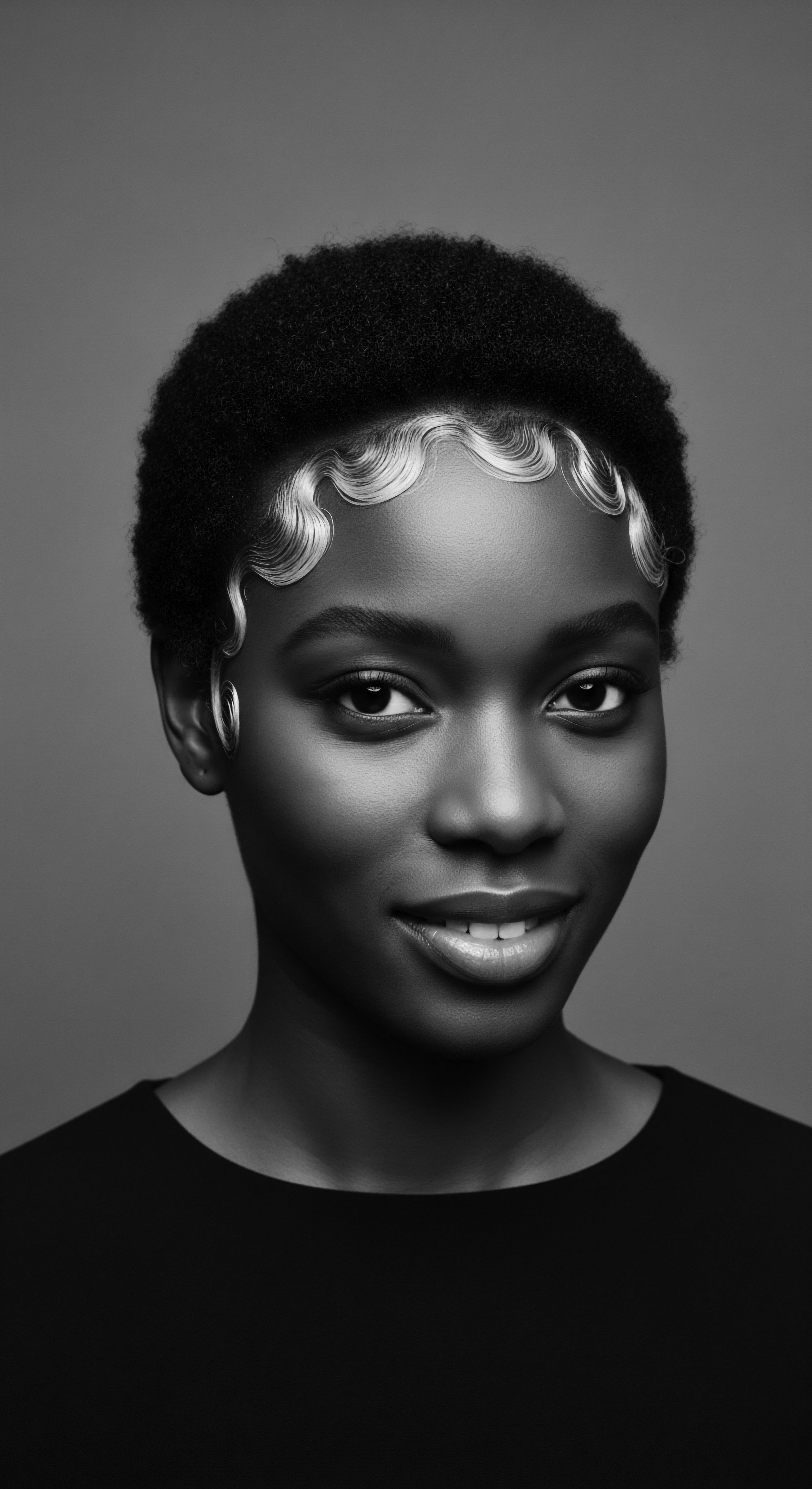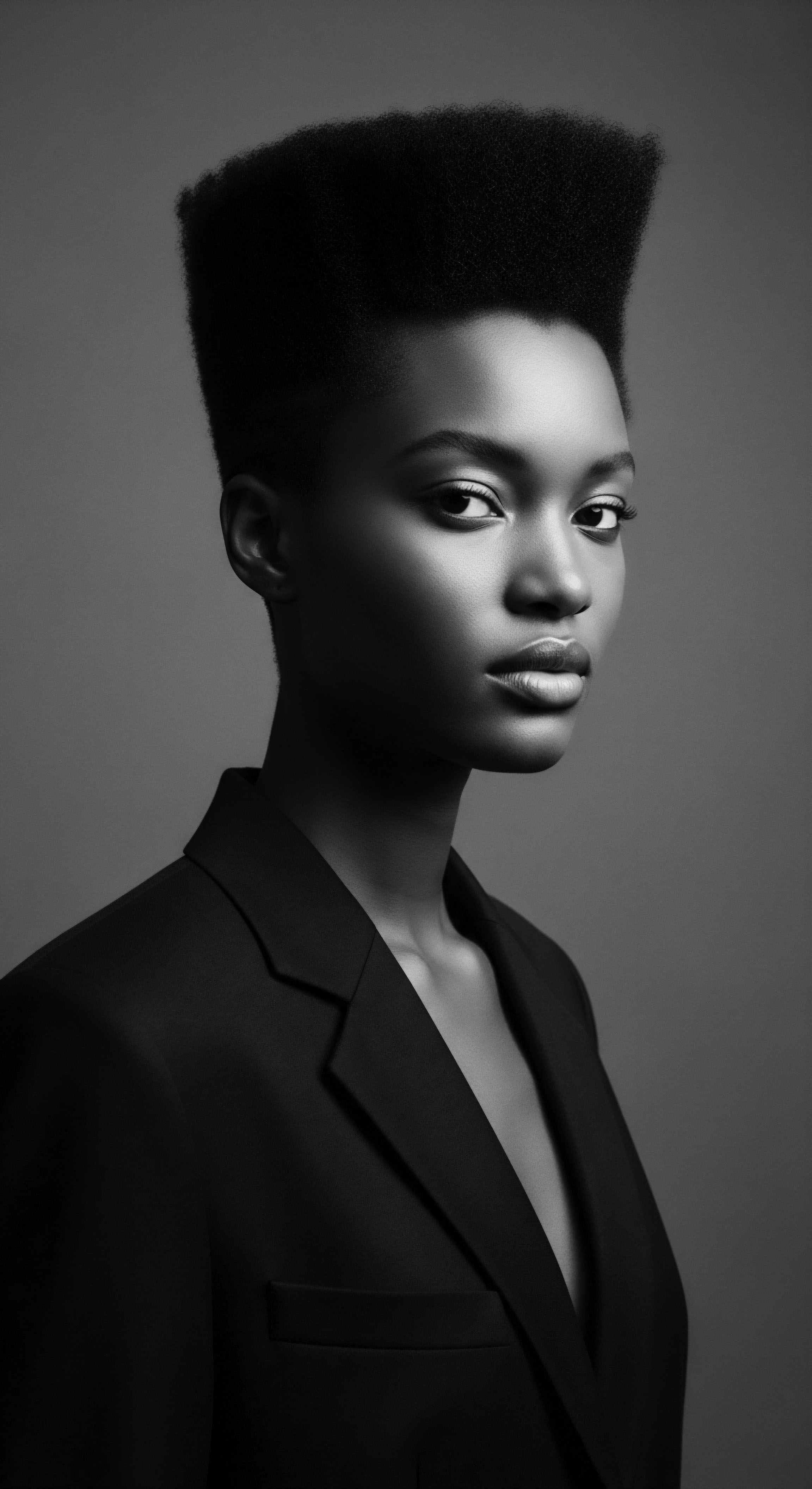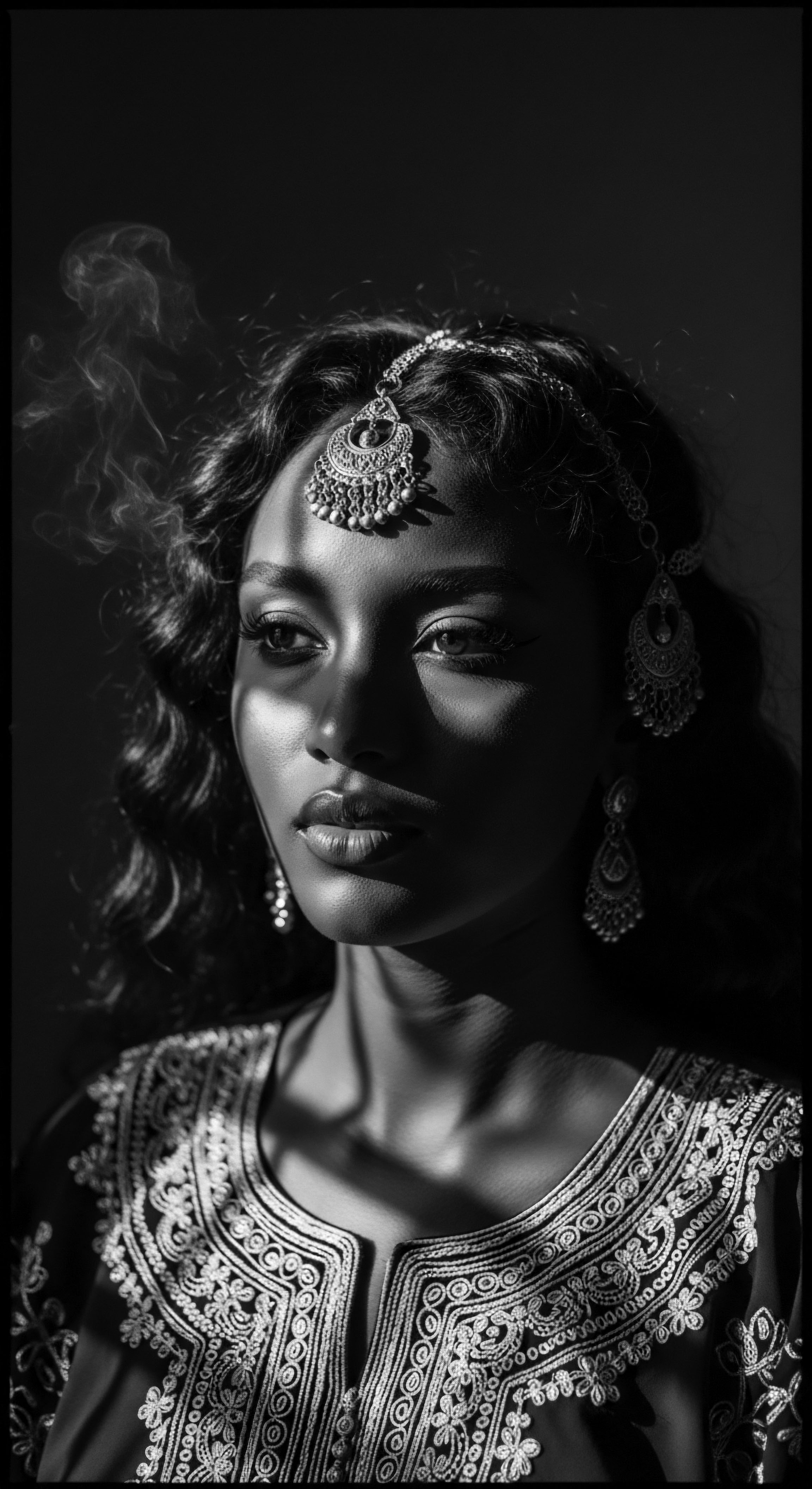
Fundamentals
The core definition of Hair Chemistry unfolds as the intricate interplay of molecular structures and reactive processes that give rise to each strand, dictating its inherent characteristics and responsiveness to its surroundings. This is not merely a dry scientific delineation; it is a profound revelation of the very fabric of our being, a story etched in keratin and bonds. For textured hair, this fundamental understanding holds particular weight, as its unique helical architecture and varying porosities are direct manifestations of these chemical principles. The ancestral wisdom, passed down through generations, often intuitively grasped these underlying chemical truths, even without the language of modern science.
Across countless ancestral communities, particularly those of African descent, the care of hair was deeply entwined with an experiential comprehension of its physical and chemical states. Before the advent of laboratories, the properties of the soil, the sun, and the plants were observed and applied. The very act of cleansing with saponin-rich barks or conditioning with nutrient-dense oils was a practical application of Hair Chemistry, aiming to balance the hair’s natural environment and maintain its vitality. This historical continuum shows how human curiosity, born of necessity and observation, sought to influence the hair’s state, recognizing its malleability through chemical means.
Hair Chemistry, at its heart, represents the molecular ballet that shapes each strand, a dance profoundly influenced by the rich heritage of textured hair and its ancestral care.
The physical strength and resilience of a hair strand, its ability to coil and resist breakage, stem from the complex arrangement of proteins, primarily Keratin. These proteins are built from amino acids, which link together in long chains. The way these chains fold and connect, forming bonds between them, gives hair its shape and strength.
Understanding this basic protein structure is the initial step in comprehending how different hair types respond to moisture, heat, and chemical treatments. For instance, the tight coils of many textured hair types are a direct consequence of the unique distribution of these bonds along the hair shaft, creating points of tension and curvature.
- Protein Structure ❉ Hair’s strength derives from keratin, a fibrous protein. Its arrangement dictates elasticity and curl pattern.
- Hydrogen Bonds ❉ These temporary connections are broken by water and reformed upon drying, explaining why hair can be styled when wet.
- Salt Bonds ❉ Similar to hydrogen bonds, these are also weak and affected by pH changes, influencing how hair responds to acidic or alkaline substances.
- Disulfide Bonds ❉ These strong, permanent connections give hair its structural integrity and are altered by chemical processes like relaxing or perming.
Ancestral practices, though not explicitly naming these bonds, developed techniques that implicitly manipulated them. Consider the traditional practice of using alkaline substances, like certain wood ashes mixed with water, for cleansing. These solutions would have temporarily swelled the hair cuticle, allowing for deeper cleansing, a process directly related to the hair’s pH and the alteration of salt and hydrogen bonds.
Following this, acidic rinses from fruit vinegars or citrus juices would have been used to restore the hair’s natural pH, smoothing the cuticle and restoring balance, a testament to an intuitive understanding of the hair’s chemical equilibrium. This ancient wisdom, rooted in observation and generations of experiential learning, laid the groundwork for our contemporary understanding of hair’s chemical responsiveness.

Intermediate
Advancing our interpretation of Hair Chemistry involves a deeper examination of the specific bonds that sculpt textured hair and how various agents interact with them. This moves beyond a simple overview to a more detailed understanding of the hair’s intrinsic architecture and its responses to environmental and applied factors. For textured hair, the interplay of its unique elliptical cross-section and the distribution of keratin within the cortex creates a distinct challenge and opportunity for care, necessitating a nuanced approach informed by chemical knowledge.
The very coiling of textured hair, from loose waves to tightly packed coils, is a direct outcome of the arrangement and quantity of its chemical bonds. While hydrogen and salt bonds contribute to temporary changes, the robust Disulfide Bonds are the primary architects of the hair’s enduring shape. These covalent links, formed between sulfur atoms in the amino acid cysteine, provide significant structural stability.
The way these bonds are distributed along the hair shaft, often unevenly in textured strands, creates the tension and torsion that define curl patterns. This chemical reality dictates the hair’s elasticity, its propensity for shrinkage, and its overall strength.
Understanding the hair’s Porosity also becomes crucial at this level. Porosity describes the hair’s ability to absorb and retain moisture, which is directly influenced by the state of its outermost layer, the Cuticle. A healthy cuticle, with scales lying flat, indicates lower porosity and better moisture retention. When the cuticle is raised, often due to chemical processing or harsh environmental conditions, porosity increases, leading to quicker moisture loss and vulnerability.
Traditional hair care practices often aimed to seal the cuticle, using methods like cool water rinses or applying specific oils, which formed a protective barrier. This intuitive knowledge of porosity’s significance predates its scientific naming.

The Tender Thread ❉ Traditional Applications and Chemical Responses
Ancestral practices were often sophisticated chemical applications, albeit without formal scientific nomenclature. Consider the use of fermented rice water, a tradition observed in various cultures, including the Yao women of China, renowned for their long, healthy hair. The fermentation process creates a slightly acidic solution rich in amino acids, vitamins, and antioxidants.
When applied to hair, this acidic rinse helps to flatten the cuticle, thereby reducing porosity and enhancing shine. This historical practice demonstrates an empirical understanding of pH balance and its effect on hair structure, directly influencing the hair’s chemical state for improved appearance and resilience.
Intermediate Hair Chemistry illuminates how hair’s unique structural bonds and porosity respond to environmental and applied factors, a complex interaction often intuitively understood within ancestral hair care traditions.
The application of certain natural clays, common in cleansing rituals across parts of Africa and the Middle East, also speaks to an intermediate understanding of hair chemistry. Clays like Rhassoul clay possess a negative charge, allowing them to draw out positively charged impurities and excess oils from the hair and scalp. This cleansing action, without stripping the hair of its essential moisture, reflects a delicate chemical balance. Such practices illustrate a deep appreciation for the hair’s needs, using naturally occurring substances to achieve specific chemical outcomes for optimal hair health.
| Aspect of Hair Chemistry Moisture Retention |
| Ancestral Practice (Heritage Context) Applying shea butter or coconut oil to seal moisture into the hair shaft after cleansing. |
| Contemporary Scientific Understanding Lipids (fatty acids) form a hydrophobic barrier, reducing trans-epidermal water loss from the hair cuticle. |
| Aspect of Hair Chemistry pH Balance |
| Ancestral Practice (Heritage Context) Rinsing hair with diluted fruit vinegars or citrus juices after washing. |
| Contemporary Scientific Understanding Acidic rinses (low pH) help to close the hair cuticle, smoothing it and reducing frizz, thereby enhancing shine. |
| Aspect of Hair Chemistry Cleansing |
| Ancestral Practice (Heritage Context) Using saponin-rich plant extracts (e.g. soap nut, African black soap) for gentle lather. |
| Contemporary Scientific Understanding Saponins are natural surfactants that lower water's surface tension, allowing it to lift dirt and oils without harsh detergents. |
| Aspect of Hair Chemistry The enduring wisdom of ancestral hair care often intuitively leveraged chemical principles, providing a foundation for modern scientific understanding of hair's molecular needs. |
The choice of oils in ancestral care also speaks volumes about an empirical understanding of Hair Chemistry. Penetrating oils like coconut oil, rich in lauric acid, were favored because their molecular structure allowed them to enter the hair shaft, reducing protein loss during washing. Surface-coating oils like jojoba or shea butter, with larger molecules, were used to provide external protection and shine. This discernment in selecting ingredients based on their perceived efficacy, now explained by their molecular composition and interaction with hair proteins, underscores the sophisticated knowledge systems that flourished within these communities.

Academic
The academic elucidation of Hair Chemistry extends beyond basic principles, delving into the nuanced molecular dynamics that govern the unique morphology and responsiveness of textured hair. This scholarly interpretation views Hair Chemistry as the comprehensive study of the hair fiber’s atomic and molecular composition, its intricate bonding structures, and the biochemical reactions that occur both intrinsically and through external applications. It is a field that intersects organic chemistry, protein biochemistry, materials science, and cultural anthropology, particularly when considering the profound impact of chemical alterations on the diverse expressions of textured hair throughout history.
At the molecular level, the distinction of textured hair lies not solely in its elliptical cross-section, but in the distribution and orientation of its keratin microfibrils and macrofibrils within the cortex. The Alpha-Helical Keratin chains are organized into intermediate filaments, which in turn form larger bundles. In highly coiled hair, there is often an uneven distribution of cortical cells (orthocortical and paracortical cells) along the hair shaft, contributing to the differential shrinkage and tension that create the curl.
This cellular asymmetry directly influences the stress distribution on the disulfide bonds, which are more numerous and more irregularly aligned in coiled hair compared to straight hair. The resilience and spring of a coil are thus a testament to these highly organized, yet tension-laden, molecular structures.

The Unbound Helix ❉ Chemical Alterations and Ancestral Resilience
The historical narrative of Hair Chemistry within Black and mixed-race communities is inextricably linked to the profound impact of chemical relaxers. These agents, designed to permanently straighten coiled hair, operate by irreversibly breaking and reforming the hair’s disulfide bonds. Early relaxers, often containing Sodium Hydroxide (lye), represented a potent chemical intervention. The high alkalinity (pH typically 12-14) of these formulations caused the hair cuticle to swell dramatically, allowing the hydroxide ions to penetrate the cortex and cleave the disulfide bonds through a process known as Beta-Elimination.
Once broken, the hair was mechanically straightened, and the bonds were then reformed in their new, elongated configuration, often through a neutralization process. This chemical transformation, while achieving a desired aesthetic, fundamentally altered the hair’s inherent protein structure, leading to potential weakening and increased susceptibility to damage.
The widespread adoption of chemical relaxers, particularly from the early to mid-20th century, was not merely a cosmetic choice; it was deeply intertwined with socio-economic pressures and prevailing beauty standards that favored straight hair. This period saw the commercialization of chemical straighteners, promising easier manageability and alignment with Eurocentric ideals of beauty. The chemical intervention became a tool, sometimes a perceived necessity, for navigating societal landscapes.
Academic Hair Chemistry unravels the molecular architecture of textured hair, revealing how chemical interventions, historically rooted in societal pressures, profoundly reshape its inherent structure and influence its enduring health.
A critical academic perspective acknowledges the long-term consequences of such intensive chemical processing. Research has indicated a higher incidence of certain hair and scalp conditions among individuals who regularly use chemical relaxers. For instance, studies have explored the association between frequent relaxer use and conditions such as Central Centrifugal Cicatricial Alopecia (CCCA), a form of scarring hair loss predominantly affecting Black women (Callender et al. 2010).
This condition is characterized by inflammation and irreversible destruction of hair follicles, leading to permanent bald patches. The chemical stress imposed by relaxers, particularly repeated application to already processed hair, can compromise the scalp barrier and trigger inflammatory responses, leading to such devastating outcomes. This provides a compelling example of how the chemical manipulation of hair, driven by cultural and historical contexts, can have significant, enduring biological consequences.
Beyond the direct chemical damage, the repetitive nature of relaxer application, often performed by untrained individuals or in suboptimal conditions, further exacerbated the stress on the hair and scalp. The alkaline environment necessary for bond cleavage can also cause significant protein degradation and lipid loss from the hair fiber, leaving it brittle, dry, and prone to breakage. This comprehensive alteration of the hair’s chemical composition and physical integrity highlights the critical importance of understanding these processes from an academic standpoint, recognizing the historical and contemporary implications for textured hair health.
Conversely, academic inquiry into ancestral hair practices often validates their efficacy through modern chemical analysis. The traditional use of plant-based oils, such as Argan Oil (from North Africa) or Baobab Oil (from various African regions), offers a contrasting chemical narrative. These oils are rich in fatty acids, antioxidants, and vitamins. For example, baobab oil is noted for its high content of omega-3, -6, and -9 fatty acids, which are chemically stable and have a molecular structure that allows them to coat the hair shaft, providing emollience and reducing water loss.
This natural lipid barrier helps to maintain the hair’s protein-lipid balance, preventing dryness and increasing flexibility. The academic study of ethnobotanical remedies often reveals sophisticated chemical mechanisms at play, affirming the intuitive wisdom of generations.
The study of Hair Chemistry, particularly for textured hair, thus becomes a powerful lens through which to view not only the biological marvel of the hair fiber but also the complex interplay of science, culture, and identity that has shaped hair care practices across the diaspora. It is a field that continues to evolve, as new technologies seek to mimic or improve upon ancestral methods, always with the aim of preserving the inherent strength and beauty of the unbound helix.

Reflection on the Heritage of Hair Chemistry
As we close this contemplation on Hair Chemistry, the echoes from the source resonate with profound clarity. The story of hair, particularly textured hair, is a living testament to resilience, adaptation, and an enduring connection to ancestral wisdom. Long before the advent of molecular biology, communities understood, through generations of observation and experiential learning, the inherent responsiveness of their strands.
They discerned which plant infusions would soothe, which oils would nourish, and which rituals would strengthen, instinctively manipulating the hair’s chemical environment to promote vitality. This inherited knowledge, often transmitted through communal care practices, represents the tender thread of continuity, linking past ingenuity with present understanding.
The journey of Hair Chemistry, from elemental biology to its role in voicing identity, reveals a deeply personal and collective narrative. The very structure of a strand, its unique twists and turns, is a celebration of genetic legacy. Yet, its journey has also been marked by societal pressures that sometimes led to chemical alterations, reshaping its natural inclination in pursuit of external validation. This historical tension underscores the ongoing dialogue between scientific possibility and cultural preservation.
Roothea’s ‘living library’ endeavors to honor this intricate heritage. It seeks to illuminate the scientific underpinnings of hair, not to supplant ancestral wisdom, but to affirm and expand upon it. The chemical language of keratin, disulfide bonds, and pH balance offers a contemporary vocabulary for what our foremothers understood through touch, scent, and tradition.
By embracing the full spectrum of Hair Chemistry, from the elemental building blocks to the complex reactions that define its character, we are invited to appreciate the unbroken lineage of care. The unbound helix, therefore, represents not just the physical form of textured hair, but the liberation that comes from understanding its past, cherishing its present, and confidently shaping its future, steeped in knowledge and reverence for its unique ancestral story.

References
- Byrd, A. & Tharps, L. (2001). Hair Story ❉ Untangling the Roots of Black Hair in America. St. Martin’s Press.
- Callender, V. D. McMichael, A. J. & Sperling, L. C. (2010). Diagnosis and Management of Central Centrifugal Cicatricial Alopecia. Dermatologic Therapy, 23(4), 406-414.
- Davis-Sivasothy, A. (2011). The Science of Black Hair ❉ A Comprehensive Guide to Textured Hair Care. Sivasothy Hair Company.
- Draelos, Z. D. (2010). Hair Cosmetics ❉ An Overview. Journal of Cosmetic Dermatology, 9(2), 165-171.
- Khumalo, N. P. & Gumedze, F. N. (2015). The Hair Relaxer and Hair Loss Controversy ❉ A Critical Review. Clinical, Cosmetic and Investigational Dermatology, 8, 175-182.
- Robbins, C. R. (2012). Chemical and Physical Behavior of Human Hair. Springer.
- Waller, R. E. et al. (2022). Hair Product Use and Risk of Uterine Leiomyomata in a Racially Diverse Cohort of Women. Environmental Health Perspectives, 130(3), 037001.
